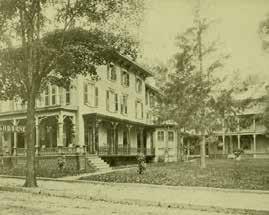
6 minute read
Bill Orzell
Spa Lodging
WRITTEN BY BILL ORZELL
Saratoga Springs has attracted tourists and visitors for centuries. The Queen of the Spas with her mineral waters, along with the spectacle of Thoroughbred racing and attendant sales, has long been a sustaining economic engine. The community is also home to the National Museum of Racing and Hall of Fame. Many have traveled here, from across the globe, to participate.
The Washburne House on Washington Street in Saratoga Springs. Saratoga Springs souvenir c. 1906. Courtesy of Library of Congress Collection. The Empire Hotel on Grove Street & Maple Avenye in Saratoga Springs. Courtesy of Boston Public Library, Digital Commonwealth Collection. The Kensington Hotel on Union Avenue at Regent Street in Saratoga Springs. Detroit Publishing Catalogue
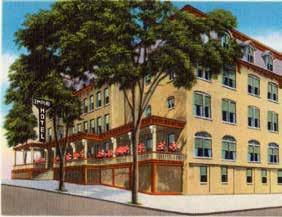
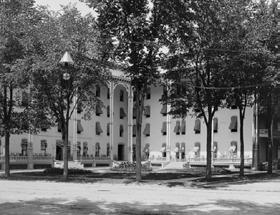
(1901-1906). Library of Congress Control Number 2106808887
Legendary hotels once stood along Broadway to accommodate the summer crowds, large and opulent; it is fascinating to consider their history. Yet also intriguing were the lesser lodgings, situated away from the main thoroughfare, and mostly seasonal. One such location was the Washburne House at 39-41 Washington Street, a federal-style structure which began serving the public in 1878. The proprietor touted the 100 rooms available in a delightful central location surrounded by a fetching lawn, convenient to the Springs, and handsomely furnished with all the modern improvements. Mr. Washburne’s advertisements assured his potential customers that his table and appointments were strictly firstclass. Prominent local philanthropists Spencer and Katrina Trask, just prior to his unexpected 1909 death, purchased the Washburne House and made it a gift to the nearby Bethesda Episcopal Church for use as a Parish House and Sunday School. Another “off-the-beaten-path” establishment where many Spa tourists gravitated was the Vermont House operated by Clarissa and Benjamin Dyer, who had relocated from the Green Mountain State to the corner of Grove and Front Streets. These street names do not register on our maps today, as Grove Street is now known as Ellsworth Jones Place, and Front Street was renamed Maple Avenue, the present-day site of the Saratoga Springs City Center. This spot was formerly occupied by the Dyer’s temperance boarding house commencing in 1868. In 1871, the Dyers erected a three story brick building, in a hotel style. This structure was further improved in 1875 by adding a mansard fourth story and roof top solarium. Clarissa, widowed in 1877, continued operation of the Vermont House on her own. A succeeding proprietor, Mr. R.D. McDonald, advertised the hotel as accommodating 100 guests and that “our tables will be as good as any.” Early in the twentieth century the structure was renamed the Empire Hotel. The hotel was close to the Empire, Star and High Rock Springs and would seasonally advertise as “the old Reliable House.” This domicile operated for many years, graciously providing for generations of customers, later offering a kosher kitchen. In the late 1940s the Empire Hotel was one of a number in Saratoga Springs that offered “free entertainment and Jewish theatrical shows for patrons.” In October 1973, the building sustained a damaging fire, and material destruction to the third and fourth floors. The City Center replaced this venerable facility on the same location, and welcomed its first guest in 1984.
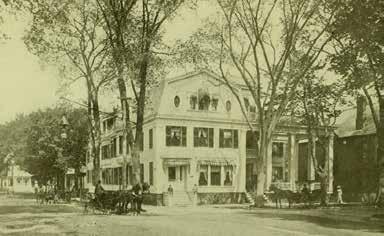
The Carlsbad on Franklin Square in Saratoga Springs. Saratoga Springs souvenir c. 1906. Courtesy of Library of Congress Collection.
The Beverly Manor on North Broadway in Saratoga Springs. Courtesy of Boston Public Library, Digital Commonwealth Collection.
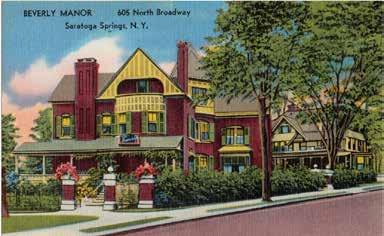
Directly across Maple Avenue, where the new parking ramp now stands, was the Elmwood Hall which advertised that their accommodations included over an acre of shaded lawn for tennis and croquet for their guests. The Elmwood, catering to the many who might enjoy peace and quiet at a downtown accommodation at the old Spa, notably advertised that they provided “No Bar,” a far cry from the present. The largest of the hotels located off Broadway was the Kensington Hotel, sited on Union Avenue at Regent Street, and arguably the most attractive hostel in Saratoga Springs, opened in 1882. Their 250 rooms were housed in an “L” shaped brick five story building, with impressive columned piazzas along the entire length, and tiered balconies at each end. These commodious piazzas permitted dining al fresco, and live music with evening dances known as hops, to take place. The interesting shape of the lodging allowed for an attractive greensward, full of blooming flowers, where eye-catching entrances could be made by visitors. The interior décor of the Kensington was mixed black walnut and cherry woodwork, mirrors, elegant furniture and parlors, lofty ceilings and carpeting, with guests reaching their rooms by elevator and through broad halls. As with the Broadway hotels, the Kensington Hotel sponsored a stakes race at the Saratoga Race Course. Several ownership groups were involved in the hotel’s brief presence, with the most notable being the German emigree Paul C. Grening. The Albany Journal in 1887 described him thus; “Mr. Grening conducts the hotel more for the satisfaction it gives him than for the income he receives from it.” He prided himself on the table he set for his guests; his chefs and bakers were of the highest caliber, and he entertained diners with one of the world’s largest music boxes. He was part of a group of proprietors who were determined to brew a select premium-hop beer, known as “India Wharf Brew,” offered only in choice establishments. Mr. Grening in 1891 was instrumentally involved with Gottfried Walbaum purchasing the Saratoga Race Course, and afterward, became the treasurer of the Saratoga Association. Paul Grening’s numerous properties proved detrimental to the Kensington Hotel when he found himself overextended to his creditors in 1894. The Hotel on Union Avenue passed through various management arrangements until 1909, when it was purchased by Union Avenue neighbors, then demolished, and the property eventually gifted to Skidmore College. The Beckmore Hotel operated in the unique and attractive trapezoidal building at the five-points on Lincoln Avenue, and this proximity to the race track made the location popular. The Germania House was located on Mitchell at Ludlow Street, on property where the National Museum of Racing and Hall of Fame now prominently stands. This public house was later converted to accommodate Saratoga’s indigent children. The Carlsbad, later known as the Hotel Russell, was built at 6 Franklin Square in 1840 and appealed to those visitors who desired Saratoga’s mineral springs for curative purposes on the belief prevailing at Carlsbad and other European spas. Mrs. Elizabeth Winde operated a lodging in a leased structure that included a German-American restaurant at 207 South Broadway, known as the New Beverly. In 1935 she had the opportunity to purchase the former residence of one of Saratoga’s leading citizens, the late Senator Edgar Truman Brackett, at 605 North Broadway. The Senator’s heir, Charles W. Brackett, was relocating to Hollywood where, partnered with Billy Wilder, they would produce landmarks of the silver screen, including the legendary Sunset Boulevard. When her South Broadway lease was redirected, Mrs. Winde relocated the New Beverly to the North Broadway location, where she had acquired a second and adjoining property. Following the Second World War Elizabeth Winde began using the name Beverly Manor, where she could cater to 70 guests that she advertised as, “an ideal place to live for a day or a month.” Visitors could expect exceptional comfort and palatial elegance, with particular attention to meals created for special diets. The attendants, chefs, pastry cooks, bartenders and the entire staff at the Beverly Manor saw to it that your experience there was, "as private as your own home." Mrs. Winde ceased her operations in 1966. Just as today, room rates varied widely, and tourists and visitors selected their lodging by what they could afford. The accommodations have always been, and still remain, a major part of the Spa experience.
SS










